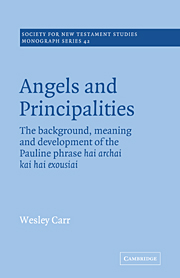 Angels and Principalities
Angels and Principalities Book contents
- Frontmatter
- Contents
- Preface
- Abbreviations
- General Introduction
- PART 1 The Background to Paul's Thought on the Powers
- Introduction
- 1 The environment in which Paul worked
- 2 The powers in Jewish and pagan thought
- PART 2 Exegesis of Pauline Texts
- PART 3 The post-Pauline development
- PART 4 Final Remarks
- Notes
- Select Bibliography
- Index
1 - The environment in which Paul worked
Published online by Cambridge University Press: 06 January 2010
- Frontmatter
- Contents
- Preface
- Abbreviations
- General Introduction
- PART 1 The Background to Paul's Thought on the Powers
- Introduction
- 1 The environment in which Paul worked
- 2 The powers in Jewish and pagan thought
- PART 2 Exegesis of Pauline Texts
- PART 3 The post-Pauline development
- PART 4 Final Remarks
- Notes
- Select Bibliography
- Index
Summary
Asia Minor in the first century A.D.
The letters of Paul may be placed somewhere between c. 50 and c. 60 A.D. It is not really possible to be more precise, and therefore we should be wary of drawing direct connections between particular historical events and specific episodes in the epistles. The letters were addressed to people living in the world of Graeco-Roman thought, politics and religion. Even where he addressed himself to Jews, as is reported in the Acts of the Apostles, his audience was by no means isolated from the pagan world. There was a common culture with its own attitudes, fears and hopes. The period may be defined, as Tacitus noted, by reference to two main events: the battle of Actium in 31 B.C. and the year of the four emperors in A.D. 68. Both events were of significance in affecting the world of Asia and Greece. The battle of Actium was the culmination of a series of events, each of which had involved the inhabitants of Asia Minor in an exaction. Caesar, Brutus and Cassius, and Antony all made their demands. As for the year 68, not only was there the well-known devotion of the eastern provinces to Nero, which issued in the persistent myth of Nero Redivivus, but the inhabitants also had to stand the cost of Vespasian's army as it moved through the provinces under C. Licinius Mucianus. Between these two events, however, there was a genuine Augustan peace.
- Type
- Chapter
- Information
- Angels and PrincipalitiesThe Background, Meaning and Development of the Pauline Phrase hai archai kai hai exousiai, pp. 10 - 24Publisher: Cambridge University PressPrint publication year: 1981
